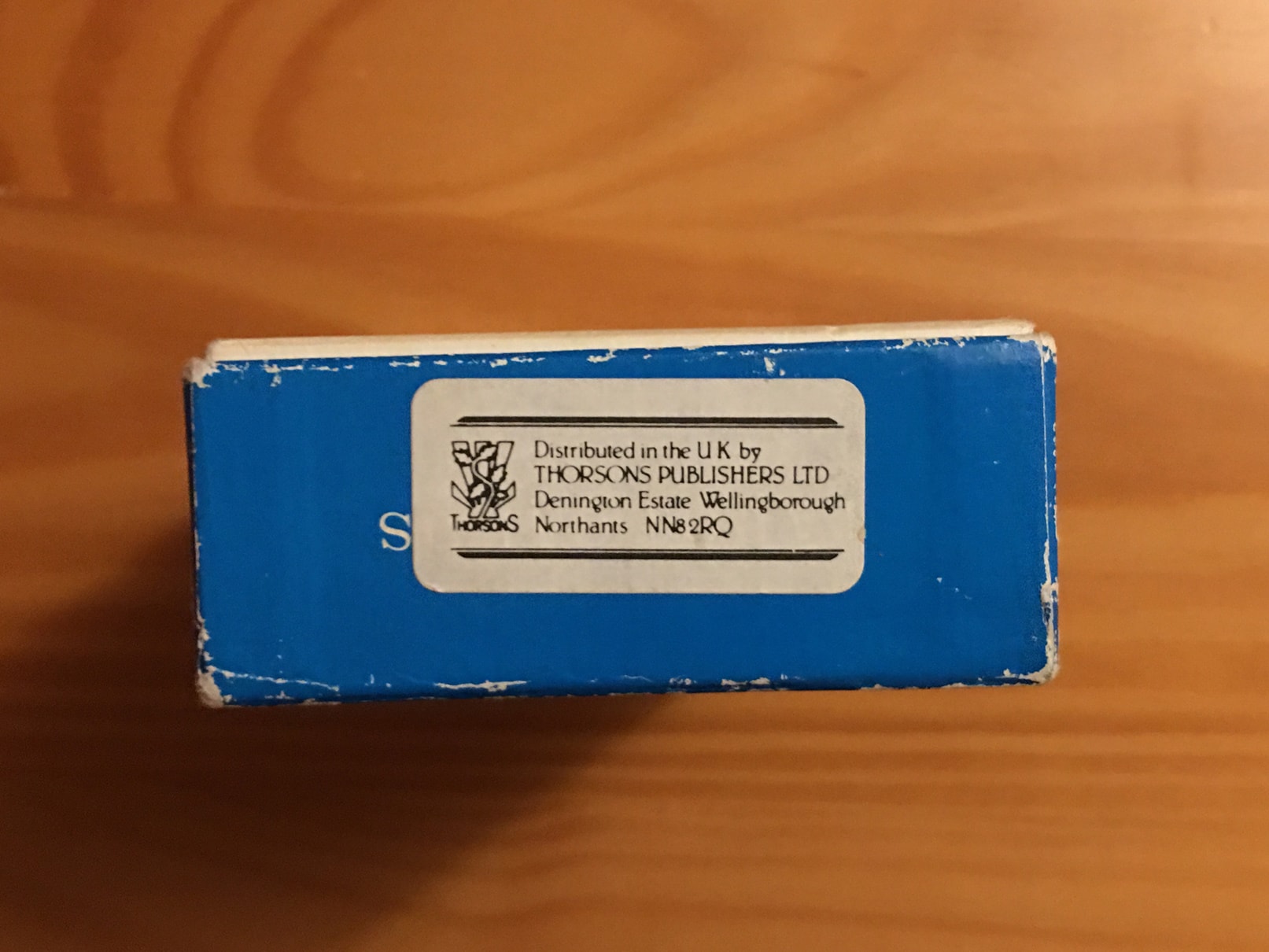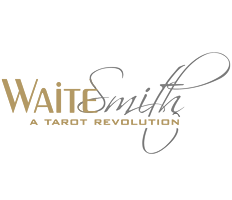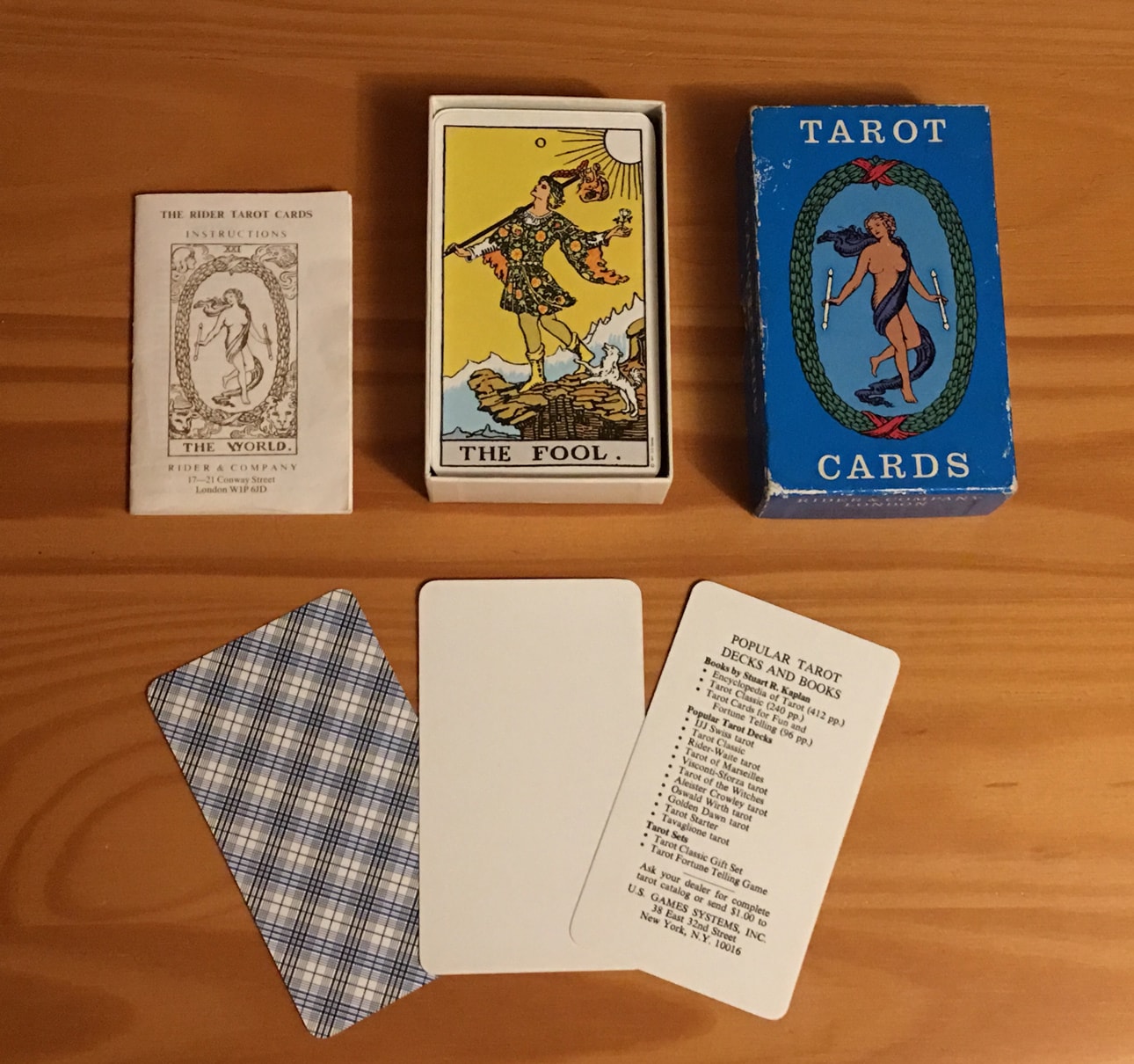
1976-77 Blue Box Rider deck
Please note: Pictures appear below.
The 1976 and 1977 Rider & Co. Blue Box Tarot cards carried a copyright notice of US Games (now USGS—it is worth noting that this copyright only covered changes made to the original art—according to the United States legal system). This is interesting as USGS and Rider & Co. both printed Waite-Smith deck clones (starting) in 1971. Rider & Co. stopped printing these Blue Box decks (or decks at all) in 1977, making this edition (on this page) the last of the bunch from the boys in England. Please note that Rider is still going strong, having been sold to become “an imprint of” a larger publisher (a really big one).
The printer of note for this, final edition, was George Over Limited and we see that Rider & Co. (ever on the move) had relocated to 17–21 Conway Street, London W1P 6JD from their previous address of 3 Fitzroy Square, London W1. That address was current when Rider & Co. printed their 1975 Traveller’s Tarot, the same address Rider & Co. had been using since 1971. The printer they had been using throughout the 1971 through 1975 print runs was AG Muller of Switzerland, the same exact printer who printed the “1JJ Swiss Tarot” (a Marseilles variant) that Kaplan (USGS) fell in love with and founded his tarot business on in or around 1970.
In none of the 1971 through 1975 “Blue Box Tarot” editions did Rider ever allow anyone to claim copyright over their 1909 creation, but the images we see, printed specifically by AG Muller from 1971 onward were of one design: the line work in question is almost certainly the same line work Pam drew and was only preserved in the (1911 and onward) Pictorial Key to the Tarot. That book, and its artwork lapsed into the public domain early on and has been published by every dog and pony show in existence, including the world’s largest media companies. The interesting thing to note on these decks (essentially every modern “Rider deck” not specifically altered) is that the colors are essentially exactly the same. So, who decided what colors to use with the new process? That is a question we may never know, but research continues (“stay tuned folks!”).
Okay, so here is where it gets really interesting (four paragraphs in . . .): This deck (1976–1977 edition) is indistinguishable from the 1971 original decks printed by AG Muller et Cie., complete with the blue and white striped backs eerily similar to the 1JJ Swiss decks (printed at least a year earlier). A note on the 1JJ Swiss, or known previously as the “JJ Swiss” tarot deck, is that it was originally published in 1860 by Johannes Müller, Diessenhofen according to the experts at the International Playing-Card Society. The only “change” from the 1971 Rider “original and only authorised edition of tarot cards”* was a copyright notice of 1971 (USGS, then “U.S. Games”).
*This is an impossible claim as tarot cards have existed since the 1700’s in France, and the Italian version of “the Tarot” known as Tarocchi (a rose by any other name) has been around since the 15th century.
Keeping with the “interesting part,” the “original” or “first time ever printed by Rider” in 1971 edition appears to be printed by AG Muller with a “pinkish-orange cream colored face” on The Fool card. It says so on the box and in the accompanying “Little White Book” (an invention of University Books, Inc. in 1960 or shortly thereafter, when they switched from the Red Box to the first “fully colored cardboard tuck box.” (L.W. de Laurence invented the tuck box for the tarot, but his boxes were plain white, and his son Velo created the world’s first “printed tuck box” but as all de Laurence decks were made specifically for mail order, and then later sold to retail stores occasionally, they only had words printed on the front, and were never accompanied by a “Little White Book.”
Ruh Roh! But what about the Blushing Fool Blue Box tarot that is so sought after? Well, here’s de poop kids. EVERY “Blushing Fool” Blue Box Rider deck—including the impossible-to-find-does-it-even-exist? “Blue Tuck Box” (1972) edition from Rider was “printed by AG Muller in association with Waddingtons.” Furthermore a shiny gold sticker appeared on many boxes stating “DISTRIBUTED EXCLUSIVELY BY WADDINGTONS.”
(facepalm)
And everyone seems to think the “Blushing Fool” deck came first, and the prices on eBay reflect this. But in point of fact, the extremely rare first edition (true 1971) Blue Box Rider “top lift” (only) decks came first. The Waddingtons exclusivity came in 1972, and you can see this on the blue box itself. To validate this “theory” all we need to do is to check the LWB that came with the deck (inside the box)—or—look on the box itself where it says “second edition.”
But what does this all mean?
Well, that depends on your agenda. If you own ANY “Blue Box Rider deck” of any size you should probably hold on to it because as Mark Twain (who died just a few days after the first Rider tarot cards were published) said about land, “they’re not making it anymore.” If you are a connoisseur, you may want to hunt down every edition, including the hard-to-find “Blue Key to the Tarot” that came with some decks and was the same size as the Blue Box decks (printed from 1971 through at least 1974). If you are a seller you probably don’t care about any of this as long as you can get over $225 (roughly the going rate in U.S. dollars for any blue box deck). But just for fun, let’s see if we can set a value on each edition based on what we know, assuming an average recent sale price of about $225 (U.S.D.)
- 1971 Blue (top lift) Box (Rider / AG Muller) — almost certainly the first print run. + $50, possibly more if a year goes by without a listing on eBay.
- 1972 Blue (top lift) Box (Rider / AG Muller / Waddingtons) — This is the “Blushing Fool” edition everyone is so ga-ga about. $225
- 1972 Blue (tuck box) Box (Rider / AG Muller / Waddingtons) — Same “Blushing Fool” edition but only three are proven to exist. +$100 (more if you can get someone to pay your asking price).
- Post 1972 through 1975 Blue (top lift) Box (Rider / AG Muller / Waddingtons) — probably -$75 but not to worry, no one will care. They will probably just think “Hey, it’s a Blue Box edition!” and snatch it up in a bidding war.
- THIS EDITION 1976-1977 Blue (top lift) Box (Rider / George Over Limited / Thorsons) — This edition was distributed exclusively by Thorsons Publishers (please see below). A fair market value would place this at less than $60 (the price it sold with a later edition (1971) of the JJ Swiss deck) on eBay just a week before this article was written (so “July 2017”). BUT . . . again, who cares? It’s a Blue Box Rider deck!! Gimme $200 or kick some rocks!
Occasionally we will see price spikes, mostly on eBay, and the prices of decks are on the rise overall every few years, but watch out for over-inflated prices, like $500 for a Red Box University Books deck (early 1960, after UB left Manhattan, even through everyone thinks they were 1959) or a standard yellow USGS deck (1971) for $200, or a 1980’s Thoth deck over $100. There will always be eBay sellers who jack up the prices of decks so impossibly high that over time other eBay sellers start thinking that this price will actually attract buyers. Most of the time these decks languish, while real “fair-market value” priced decks sell in a few days at a “buy it now” price. Don’t get screwed. If you want to know if a deck is priced at a bargain or not please contact us immediately. We will give you a professional assessment, even if we have to ask everyone on the research team (all over the globe), in which case it might take a few days to get you the best answer. The worst (and completely unrelated to Blue Box Rider deck prices) abuse of deck inflation are the Aquarian Decks that claim to be “1971” but in fact are 1972 through 1980 editions, and worse, the ones printed later by USGS (not “bad” just worth a LOT less and far more common).
So that’s a quick primer on the 1976–1977 “Blue Box decks” from Rider & Co., and how to spot them amidst previously printed decks. Any deck is a good deck if you like it and refuse to pay too much to get in into your eager handses. If you have any questions, comments, or suggested corrections please contact us at any time.
Thanks for reading this, here’s some pictures!
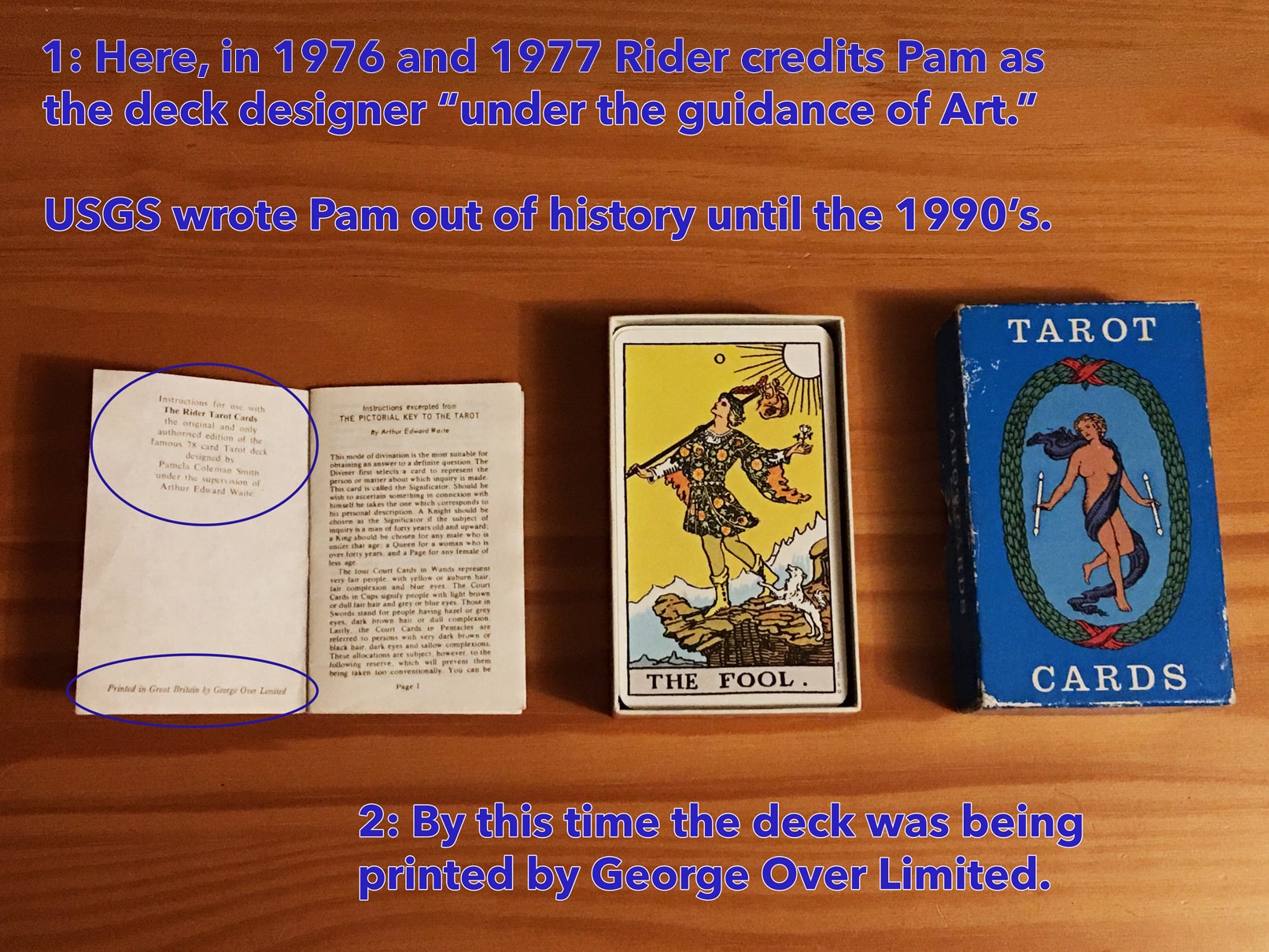
This is how you know when you have a 1976 or 1977 ``Blue (top lift) Box`` Rider tarot deck.
The outside of the box says “AG Muller” but the LWB that came inside the box tells the real story. Well, that and the address change on the box itself.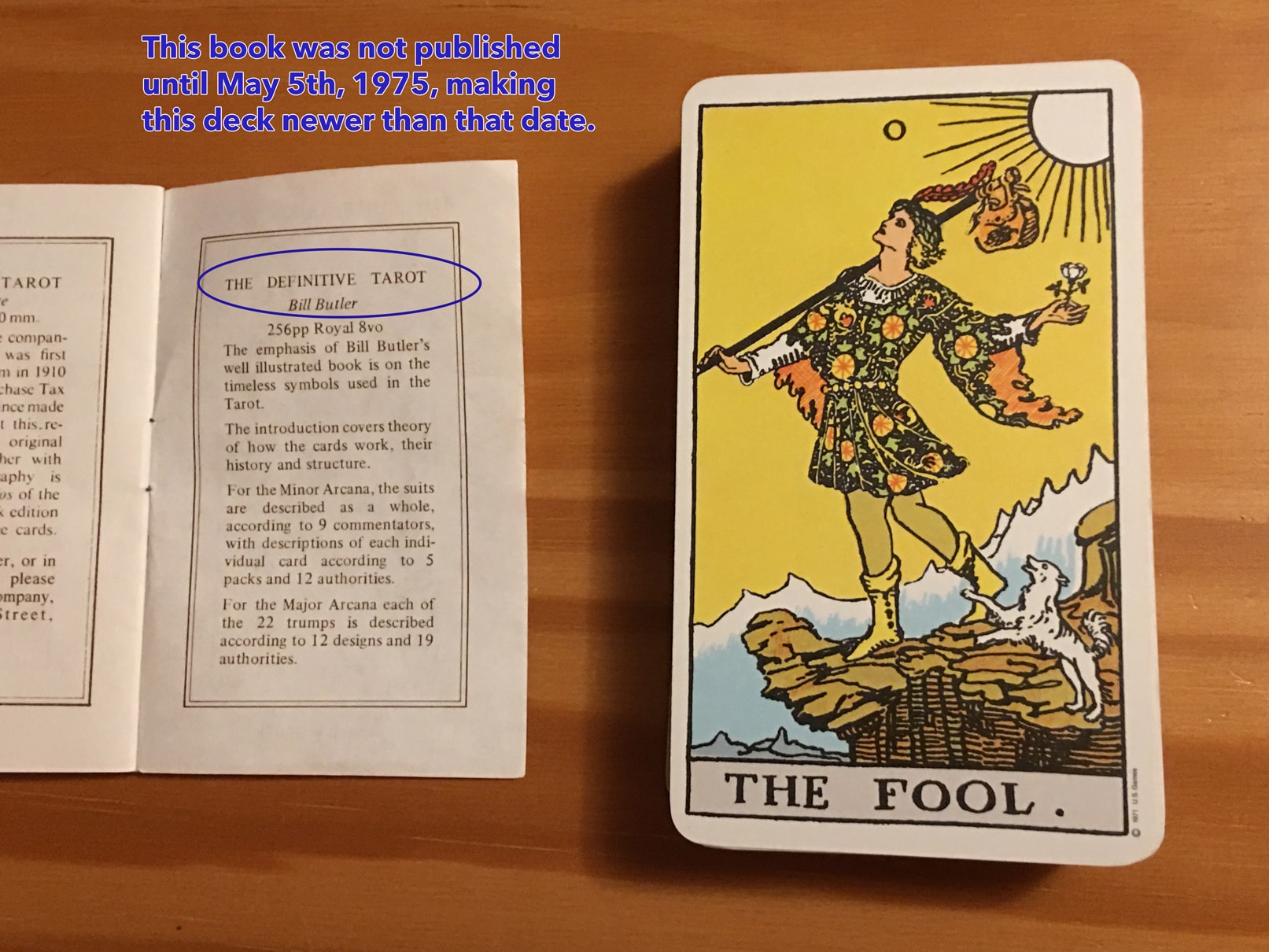
This book was not even published until 1975!
As we can see here, The Fool is back to his “cream colored face” (nice and smooth—no measles) and the book advertised in the back of the LWB (something Rider had done since before 1910) did not come out in “1971” despite any implied claims that this deck could be from that year. This means that George Over Limited used the same color plates that AG Muller used in 1971 and reverted to “the old box” (pre-Waddingtons), or that AG Muller returned to printing the decks with the original style in 1976 and 1977 and the “Little White Book” was printed by George Over Limited with no other credits mentioned anywhere. The first scenario is the most likely one.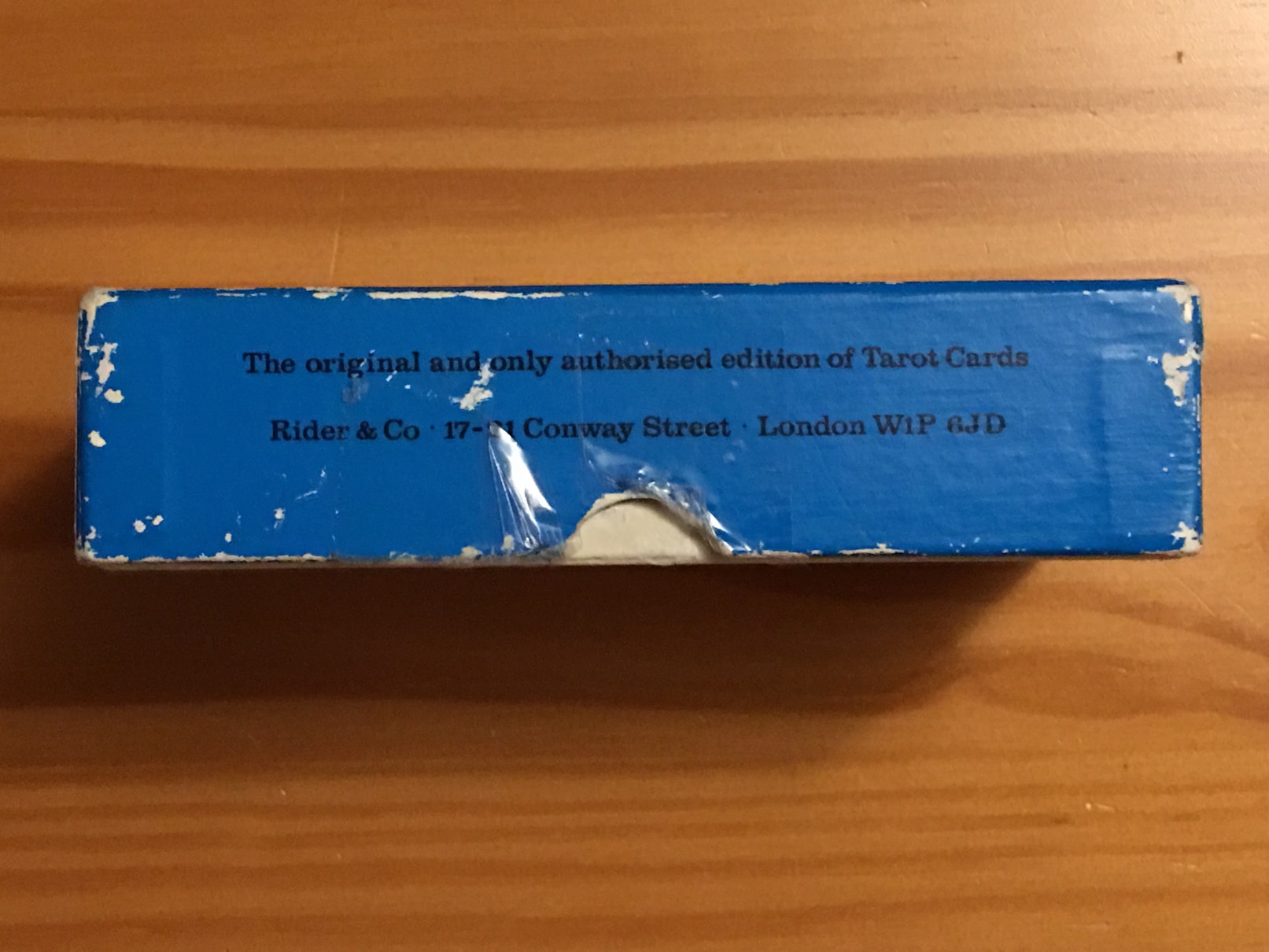
What? Rider moved *again*?!!
Those wacky folks at Rider must have been Geminis or Sagittarians, as they moved all over London, from building to building and down the street every few years during their subsequent tarot deck runs. This is the last address to appear on any of their tarot decks, and the only one to appear in 1976 and 1977. Please note that this is the RIGHT side of the box and on the left “AG Muller & Cie”was printed as the printer, and the bottom side of the (top lift part of the) box says nothing about “second edition.” Those words only appeared from 1972–1975 on the “Waddingtons” editions. It looks like George Over Limited simply used the old plates (circa 1971) from the box and cards, squeezing in a “Copyright” on the cards themselves (please see below).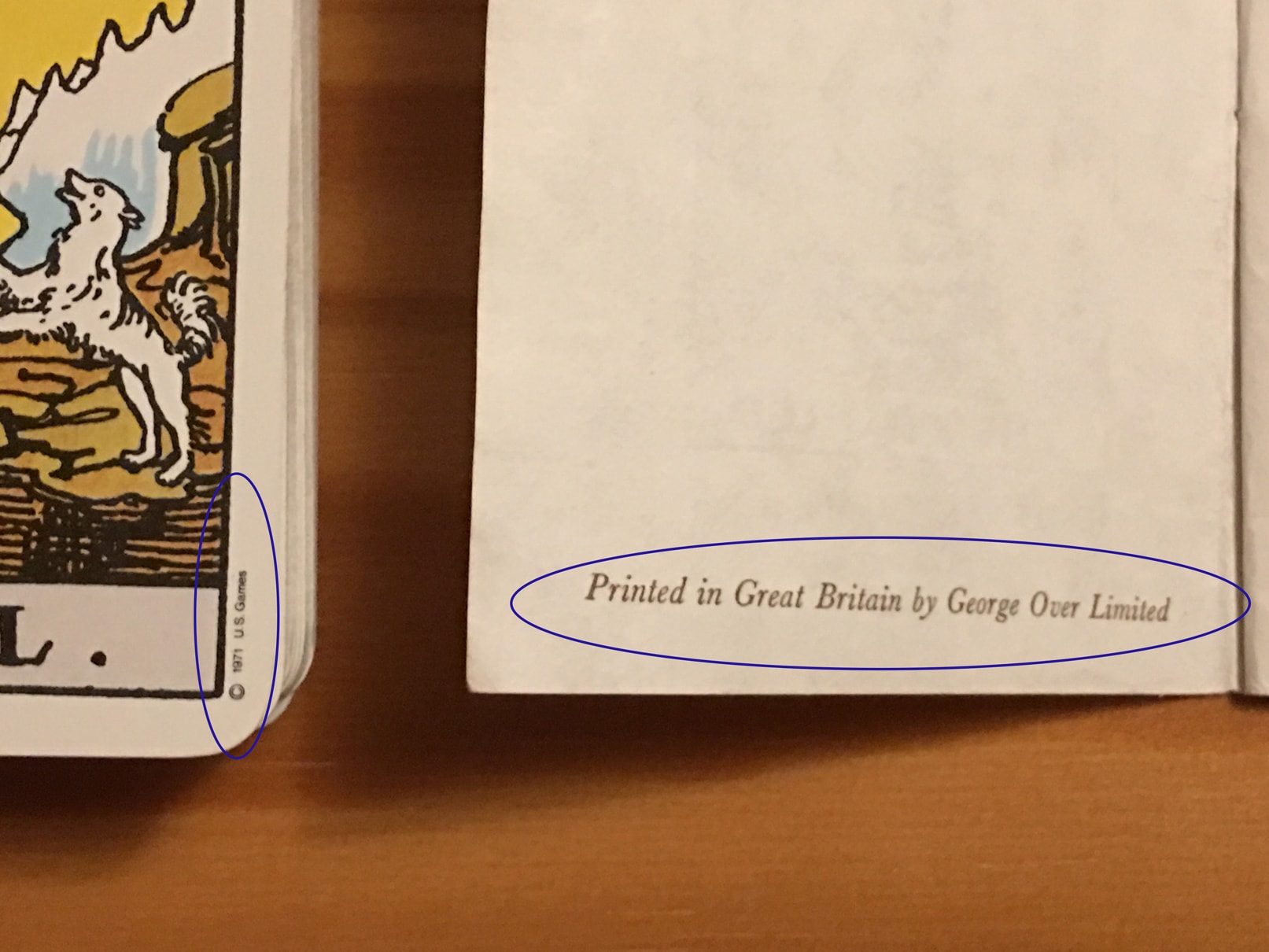
How did MY COPYRIGHT get on YOUR cards?
. . . or “How did MY OIL get under YOUR sand?” Here we see Rider (the company who INVENTED the modern tarot) ceding copyright to US Games (the company that started selling Rider’s tarot cards 72 years AFTER Rider invented them). How strange history is written when you have a room full of lawyers and an aggressive CEO. Also note here that the new printer, George Over Limited, reprinted what appears to be the 1971 deck exactly as it appeared (down to the exact ink color on the LWB, and the box itself) with only an address change to prove that Rider did not “just use old decks that were found in a warehouse.” Strange Days.